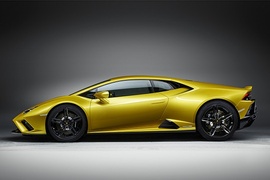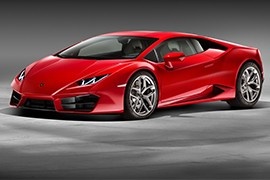
LAMBORGHINI Huracan
Generations Timeline, Specs and Pictures

The 2019 Lamborghini Huracan received a facelift, an improvement for the next decade.
The new engine offered is the 5.2 liters naturally-aspirated Lamborghini V10 engine but upgraded for more power and a powerful sound.
Amongst the new technologies that made this engine magnificent, there are titanium intake valves and a lighter exhaust system. The Huracan Evo produces 640 hp and 600 Nm (442 lb.-ft) of torque. For the transmission, Lamborghini has opted for a 7-speed dual-clutch gearbox, which sends the power to all four wheels. Due to this combination of powerplant and gearbox, the Huracan Evo gets a 0-100 kph (0-62 mph) time of 2.9 seconds and a top speed of 325 kph (202 mph).
The Huracán EVO features Lamborghini’s new rear-wheel steering and a torque vectoring system working on all four wheels, while at the heart of the car is a new feature called Lamborghini Dinamica Veicolo Integrata (LDVI): a Central Processing Unit that controls every aspect of the car’s dynamic behavior.
A new 8.4” HMI capacitive touchscreen, located in the center console just above the start button, puts connectivity at the driver’s fingertips, with multi-finger gesture control. Governing car functions including seats, climate and the status of the LDVI system in real-time it also puts all infotainment, such as Apple CarPlay with smartphone integration, at the cabin occupants’ disposal.
A multimedia system incorporates connected navigation and entertainment, including web radio and video player. Android Auto is not available, but Android-based smartphones can connect to the audio system for telephone use.

The three letters from the Hurracan STO came from the Super Trofeo Omologata, which meant a road-legal super sports car developed on the track.
Lamborghini was one of the greatest carmakers who found a way to offer the same car at various performance levels. Moreover, apart from the factory’s management, nobody knew exactly how many new versions would be for the same car. But it wasn’t just some posh on the wheels and a new badge on the dash. The STO, for instance, was fierce and competitive. It was the fastest Lamborghini to date.
The Italian carmaker took its inspiration from the motorsport arena, where it ran the Lamborghini Trofeo race. It was noticed that it was a very good idea to install a single bodywork element that will comprise the hood and the front fenders, so they did that for the SFO and named it “cofango”. That allowed them to create new air-ducts on the front hood to increase the airflow through the central radiator and improve engine cooling as well as helping generate downforce. The cofango also incorporated a new front splitter, directing airflow to the car’s newly designed underbody and to the rear diffuser. In the rear, there was a new air-scoop to improve the cooling.
The Hurracan STO interior reflected the lightweight concept of the exterior with the extensive use of carbon fiber throughout the cockpit, including carbon-fiber sport-bucket seats wrapped in Alcantara. Carbon-fiber floor mats replaced the carpets, to reduce weight. Behind the seats, there was a high-grade titanium alloy arch with four-point seatbelts.
Lamborghini installed an upgraded drivetrain and offered the Hurracan STO with a 640 hp V10 engine. It was paired to a 7-speed automatic (dual-clutch) gearbox, which sent the power to the rear wheels.

Unveiled less than a year after its all-wheel-drive big brother, the Lamborghini Evo RWD is a true driver’s supercar in the modern Lamborghini lineup.
Just like the AWD Huracan Evo, the rear-wheel-drive model has a front/rear weight distribution of 40/60 and sits on a double wishbone suspension with overlapped quadrilaterals and passive shock absorbers. That being said, the electro-mechanical, servo-assisted Lamborghini Dynamic Steering (LDS) has been tuned specifically for the Huracán EVO RWD to offer even more driver feedback.
The supercar is powered by a naturally aspirated 5.2-liter V10 delivering 610 hp (449 kW) of power at 8,000 rpm and 560 Nm of torque at 6,500 rpm in a model that is even lighter thanks to the front axle losing a driveshaft. The fast-revving ten-cylinder engine is paired with a seven-speed dual clutch gearbox that ensures lightning-fast gear changes. With launch control, the quickest acceleration to 100 kph (62 mph) from a standing start is done in no more than 3.3 seconds. Top speed is also a more than decent 325kph. The Lamborghini Huracan Evo comes as standard with 19 inch Kari wheels engulfed in specially-developed Pirelli P Zero tires. Stopping power is more than enough since the car is fitted with ventilated and cross-drilled steel brakes. Larger 20 inch wheels and carbon-ceramic brakes are optionally available.

When you’re out to replace a car like the Lamborghini Gallardo, the most successful model in the brand’s history, you just know you have to keep everything razor-sharp.
This seems to be the way for Lamborghini’s Huracan, or LP610-4 as pedants call it.
Carbon fiber has found its way next to the aluminum in the chassis, which means that the supercar now has a dry weight of 1,422 kg (3,135 lbs). The Italians also talk about a stifness increase, but actual figures are replaced with metaphors.
At the center of the Lamborghini Huracan, we find a reworked version of the Gallardo’s 5.2-liter V10 unit. The powerplant gains direct injection, mixing this with indirect injection to offer “Iniezione Diretta Stratificata” (IDS). The results? 610 HP at 8,250 rpm and a maximum torque of 560 Nm (413 lb-ft) at 6.500 rpm. At the same time, the fuel consumption has been lowered to 12.5 l/100 km (18.8 mpg).
Gone is the single-clutch automated manual - the e-gear was replaced with Lamborghini’s version of the VW Group’s seven-speed double clutch automatic, the Lamborghini Doppia Frizione” (LDF).
The list of tech updates also includes goodies like electronic control for the AWD system. Oh and let’s not forget the ceramic brakes. Dipping into the list of optionals, we find treats such as Lamborghini Dynamic Steering (with variable steering ratio) and magneto-rheologic suspension. All these features may seem normal in the supercar world, but the Gallardo’s decade-old design meant it didn’t offer such amenities.

Lamborghini ended its customers’ wait and introduced the two-wheel-drive Hurracan in 2016, and the result was a less performant and more playful car.
Lamborghini was not keen to make an all-wheel-drive car in the ’80s, but it had to admit that the engine power became too high for a two-wheel-drive vehicle. But in 1993, the Italian carmaker made the Diablo VT with a viscous center differential (VT stood for Viscous Traction). When Audi stepped in, the German carmaker pushed the carmaker in the all-wheel-drive era for most of its models. But somewhere, the Italians knew that a Lamborghini driver would seek the traction limit and would try to make some donuts in a parking lot or a slide on a track-day. So Lamborghini made the Huracan 580-2 specifically for them.
From the outside, there were slight differences between the all-wheel-drive Hurracan and the 580-2 version. On the rear-wheel-drive version, the carmaker added a horizontal slat in each of the front wide side-scoops. In the middle, the lower lip was black regardless of the car’s color, while on the all-wheel-drive model, it was body-colored.
Inside, the 2016 Gallardo 580-2 featured a pair of sport bucket seats with high bolstering on their sides. The carmaker placed the buttons for the transmission, the parking brake, and the engine starter on the massive center console. The car was available exclusively with a seven-speed automatic (dual-clutch) transmission with paddle shifters mounted on the steering column.
Lamborghini installed the same 5.2-liter V-12 from its all-wheel-drive sibling in the engine compartment, but the engineers de-tuned it by 30 ponies to 580 hp. In addition, since the car’s front was lighter after the engineers removed the differential and the drive-shafts, the mass distribution changed to a 40/60 ratio.

Lamborghini was not pleased with the performances offered by the Huracan.
It added more power and made it faster with the 2017 Huracan Performante (performance) series.
In March 2017, Lamborghini unveiled the Huracan Performante at the Geneva Motor Show. It was one of the special editions made by the Italian car-manufacturer for its vehicles. It was usual for brands such as Lamborghini, Ferrari, or Aston Martin to build special editions for already launched vehicles and sell them with more money, even if under the skin it was the same car. But the Performante was more than that.
At the front, the new design for the bumper. It had no grilles, emphasizing lightweight materials, efficiency and sportiness. The side-sills were bigger and were built from carbon-fiber. In the back, a clear cover for the engine compartment was enhanced with more air-scoops. The rear, massive, wing, was crafted from one piece, using the Forged Composite technology.
Inside, the air vents, paddles, door handles and the center console were made from Forged Composite. The driver was in touch with the active aerodynamics’ activities: not only through the car’s performance but from the special ALA graphic in the dashboard display.
The Huracan Performante was stiffer than the coupe version. It was fitted with magnetorheological adaptive dampers, for higher cornering speeds. The car was 40 kg (88 lbs) lighter than the standard Huracan, which lead to better 0 to 100 kph (0-62 mph) time.























































